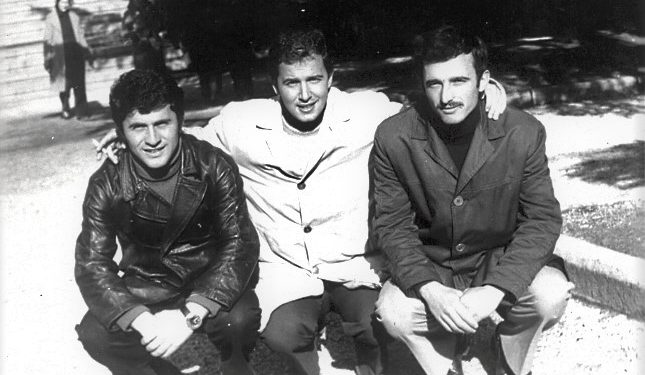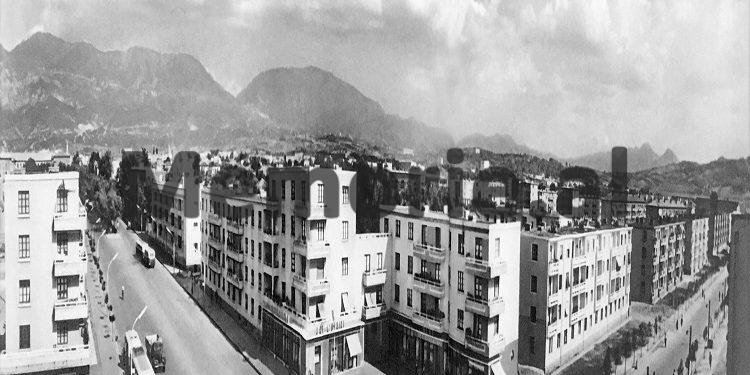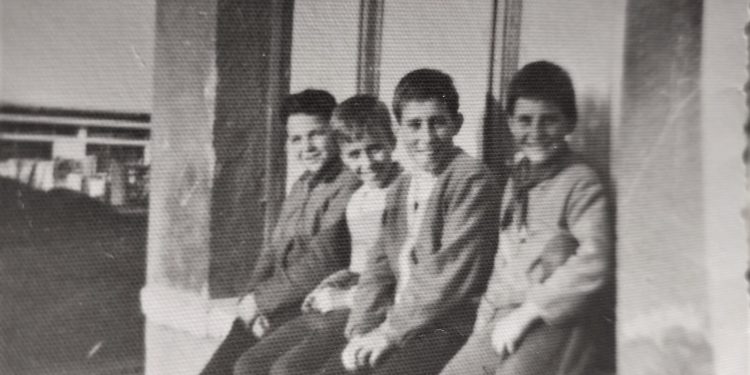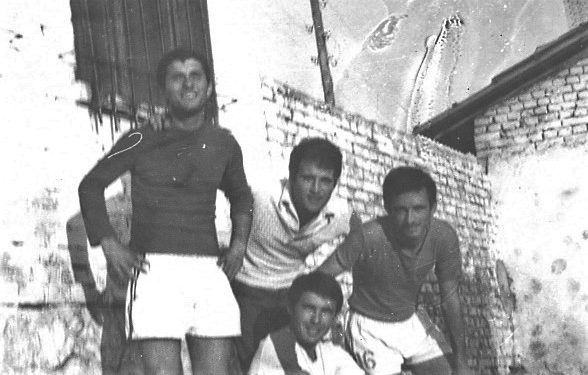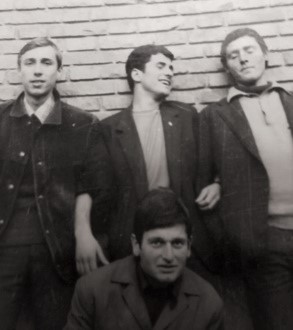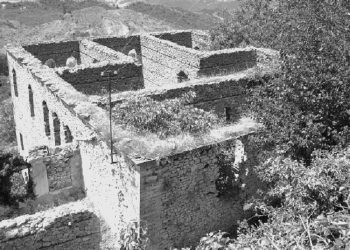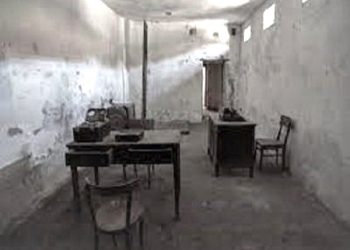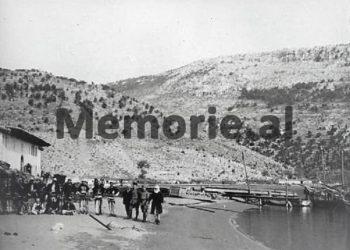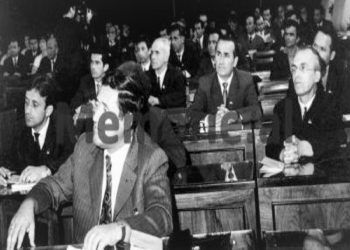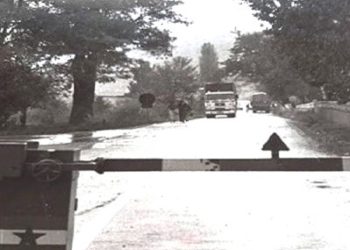From Uvil Zajmi
Memorie.al / What were the buildings that were erected first, in the Block of “21 Djetori”, starting from enterprises, schools, shops, to residents and well-known characters, such as: teachers, singers, painters, sculptors, writers , aviators, athletes, from Marie Kraja, to Prodani, Dionis Bubani and Zef Bumçi and who were the Montenegrins who lived there? Doctors of Ambulance No. 9, and the story of the family of Koci Xoxes, and the sensational escape of the Andoni brothers! The whole history of the famous neighborhood that even today continues to be known as the birthday of the Soviet dictator, Joseph Visaranovic Stalin!
Continues from last issue
Palaces and residents, VIPs of Tirana
From Prodani, aviator Gjiknuri, prof, Demiraj, and Nikolla
The second palace from that wing was the one where the family of major officer P. Pano, with his wife Efigijeni, lived; the family of I. Xhaxhiu, that of H. Mezhda, (known to have six children); the Sula family, with Shpresa, Gani Pepa, and that of H. Aliaj, physical culture teacher; the Xoxi family and sisters Roza, Linda, Rudina and brother Renato; V. Liko, Director of Geology, with his wife Theoni, daughter Irena, teacher of mathematics. Next to them Dh. Kocani with his mother Antigoni, a Greek from Sparta.
The family of V. Tola, Dean of Veterinary Medicine, that of D. Shoshkic, with the three children, then of the aviator Thanas Gjiknuri, with Diana, Artur and Spartak, unfortunately separated from life a short time ago. Prof. lived on that floor. Shaban Demiraj, together with the pilot’s family, were the only ones with a telephone at home, where the residents went to talk.
The Hamzaraj family with Uci of physical education and Abazi (Abin), the brother; P. Hoxha, prosecutor and A. Tola, the director of the “Kosova” school. But, that palace is also famous for several families of artists, such as that of the musicians Prodani, Anita, Agim and Kujtim, along with the family of the singer Eda Zari. Also, the painter Qamil Grezda lived there with his family, as well as the sculptor Llazar Nikolla.
The towers, where the alarm siren was placed
The first one from the right is the one above the Post Office, on whose terrace during the years of the people’s preparation for war, the alarm siren was placed, the armament in case of an air attack, lived the child Minella Andonit, known for the great escape of the year 1988, the family of F. Verçani, doctor at Ambulance No. 9; the family of sisters with Ledra, the beautiful Voc, married in Canada; The Tërkuçi family, with Qani, Kauzio’s friend, also known for his clandestine relationship with the daughter of the Yugoslav embassy, brother Titi, a Louis Armstrong, as a trumpet player in the Estrada of Tirana, as well as Hilmiu, who waited for tickets at the “Republika” Cinema.
Actors Sherri Mita and Lazër Filipi lived next to them in a private house. While in the other one, the 5-story one with the basement below, former politician Arben Demeti spent his youth with his brother, Ilir volleyball player, Mir Findiku, jeweler and coach at the same time. Adjacent to it in the southern direction, the palace that connects the tower with “Sabaud Grabranin”, was the Haxhinasto family with the brothers Edmond (former minister and well-known politician), Altini, Caslli, with Shefqeti, the former referee of FIFA, the family of sportsmen P. and Jeta Pelivan, that of J. Malo and T. Kaliven, a veterinarian by profession, but also exceptional in electronics, when he made the first tape recorder in Albania.
Towards the “Enver” Plant, houses and families
After the Post Office building, there are two others: The first, a four-story one, where the Perleka family, that of Ladi, M. Bejleri and their children, the doctor Arben and her daughter Dita, as well as the family of Mustafa Grëbleshi lived; sisters Dobi, Zakja, Dëshira, Arta, Vali, the family of the translator Halit Selfo, that of Florina, Çuc, the well-known actress of the Puppet Theater, of the engineer E. Dhrami, the family of Mehmeti with Igli and Moza, that of the Bebi and Gole brothers , that of Vaska and Fred Rrap, etc.
Then, the slightly larger next one, built on the Mënikve Mill, in which the actress Eva Pëllumbi, the well-known volleyball players Monda Beqo, Moza Ibrahimi and M. Dule, the family of prof. B. Hakanit with his wife Zana, children Liva and Tauland, veterinarian, in front of them is that of Agim Çifte, (Chief Engineer of the “Enver Hoxha” Autotractor Plant, in Tirana), also known for his love affair with Ivona Luloçi, one of the most sensational in Tirana ; the Karaiska family, with Elsa and Gerard, that of E. Hoxha, that of Xhani, with Gynecologist Spiro, family fans of Spain and “Real” Madrid.
The brothers Dedja, Fatosi the fan of “Jugoplastika”, Ylli e Timi also lived there; the family of Eng. Fred Djata, the singer Burbuqe Rada, that of Vedat Buzi, former chief engineer of the “Ali Kelmendi” Food Factory, graduated in Poland, who was convicted as an “enemy of the people” and died in Ballsh prison. Together with them, the Jani family, with Lipi, Alqin and Ari; that of Dhori Hanxhar, with sons Taku and Ben, the Strepi family, the Leka family with Rozeta and brother Jani, etc.
Other well-known people: Pal Mirashi, elegant professor, former footballer of the National Team
To continue with the palace near where M. Berberi lived, that of Fedra Rama, RTSh employee, Armenian family Stani, that of basketball player Pjerin Bushati, football player P. Mula, Dynamo volleyball player A. Panteqi, cyclist Feraizaj, swimming coach, E. Muzina. The family of K. Bozhigrad lived there. In the other palace, there was A. Nikshqi, the football referee and his son Durimi, champion swimmer and dancer, she Kukaviqi, with the basketball player brothers, Lorenc and Alban.
The Leka family, with daughter Rozeta, son Fredi, and Pal Mirashi with wife Saide, sons Alcid (Puni, former football player of the “Kastrioti” team from Kruja), and Anton (Boni). Very elegant, always in double-slit jackets, with the red Italian “Chiapini” bicycle, Professor Pali, the football master and former National Footballer since the Balkaniad of ’46, would stop at the Square, whenever he came back at lunch or evening. S. Qirjaku, professor of mathematics, French and chess master, lived a little further.
From Xon Eshja, to the Mayors
On the other side of the street, symmetrical buildings with those in front, behind the tower with the bakery and pastry shop below, up to the wall of the “Enver” Factory, there are four of them. The family of Ramazan Eshje, the intellectual, choir singer at the Opera and Ballet Theater, with exceptional culture, lived in them; that of Skënder and Edmond Tupjes, the family of the doctor Gj. Ndrenika, the neighborhood gynecologist, teacher L. Strakosha and Edi, the cellist son; the actress Rozana Çeliku, the Çeçja family, with sons Firdus, Agron and Shkëlqzen and sister, Petro Gjini, the mathematics teacher at the Polytechnic.
The Bega family, with sons Genci, Arjani, Goni, Neri, all over 1.80 m tall. Even Mani Guri, the glassblower known to his brothers, Tiku, a polytechnic by profession, lived there, as well as Fredi, a soccer player of “Textilist” and Sister Renata, a basketball player. In that block, Gaqo Apostoli, the deputy engineer, also spent his youth, as well as Ingrid Shuli’s family. For curiosity’s sake, two mayors of Tirana also lived in the third building: the families of Tomorr Malasi and Sali Kelmendi. Behind them, was the Palace of Officers?
The building in front of “Sabaudin”
Circus actors, very well known, Pina and Pineu Shkurti, the family of Todi Jankut, (famous boxer, national champion in several years), with sons Leo and Berti, that Sokrat Moskos, cameraman at the former “New Albania” Cinema Studio , wife Nora Dragusha, dancer of the State Ensemble of Folk Songs and Dances. The Hajmeli family, with aunt Xhina, Stefani, musician in the State Ensemble, and sons: Renato e Lorenc, as well as Shuaip Krypa, conductor and musician in the choir of the Palace of Culture, etc.
Lad Grillo: On Mapo, from Bubani, to Zef Bumçi
It stood out from the others as it had the Gastronomy, Mapo and the bus station as reference points. “That building was in the shape of a “Z” with a connecting tunnel and a communicating balcony for the families on the fourth floor” – remembers Vladimir Grillo, the well-known TV journalist who together with his father Dhimo, mother Zoica and his brother… they lived there. “Before, we lived in the former Soviet palaces at the “11-Janari” school, but with the arrival of the Russians, they moved us to the one-story “pupulity” in front of the “Enver” Factory.
A heavy rain flooded them, after which they settled us on the “21st”. On one level we had the family of the well-known writer, Dionis Buban, sons Ilir and Skender. Professor Sadik Meqemeja lived there with his wife Vali, the wife of the State Estrada actor Enver Dauti, the family of Zef Bumçi, the well-known cartoonist of “Hosten”. Also there was Haxhi Tafaj, singer in the Opera, S. Morina with her ballerina sister, Muharrem Afezolli, an employee at Radio-Tirana.
- Shima’s family, daughter Luli and sons Mondi, Edi and Arti, a professional tailor known throughout the area. Also the family of Dhori Hanxhar, former head of Sport-Klub “17 Nëndorit”, with daughters Tana and Rita. The athlete Sh. Pasmaçiu, one of Elvis Presley’s fans. I finished high school and university there and got a job at RTSh” – remembers Lad Grillo with nostalgia.
The Red Palace was also known to be unplastered
An unplastered building, with red bricks, hence its name, was part of “21”, in front of the Museum, where artists, sportsmen, journalists, publicists, from the famous singer Naile Hoxha, to Mehmet Elezi have lived. , E. Shalsi with his sons Petrika and Gjergji, that of Kostandin Shkurt, the basketball player of “17 Sub” with his brother, Arjan. The family of Arjan Sejko and Professor Emin Sejko was also there. In that block, lived the family of Jhilda Kosta, athlete, separated from life at a young age. Back, in a private house, the well-known writer and actor, Skënder Plasari, as well as the well-known barbell coach, Hektor Shaqiri, lived. Then came the ambulance building, with the third floor for citizens, where the Meta family lived among them, with their daughter Desada, a well-known television journalist, as well as the Ajazi family.
Soviet-style two-story buildings
There are only eight such, parallel to “Kavaja” Street, located a few tens of meters in depth from the right, and which continue to the former “Partizani” Sports Club. They are special as they are the only two-story ones, built according to Soviet architecture, by the Russians themselves in 1956-’57, covered with a roof, and with an entrance from the north.
Many prominent families have lived there, such as that of the well-known singer Nertila Koka, sportsmen E. and Gavrosh Kavaja, Tirana and national football player, Arjan Bimo. During his military service, the well-known football player of “Vllaznia”, “Partizani” and the National Team, the “Deserved Master of Sports”, Sabah Bizi, lived there with Fici, the gymnast’s wife, in an apartment provided by the Club. “Partizani”. Serxho and Aldo Gjeçi, the Dupinin family, that of the journalist K. Hoxha, the family of doctor Shkëlqim Koçiu, that of Sotir Çok, but also the family of Omer Lani, with their children Viktor and Besa, also lived in those buildings.
Irini, the Tirana volleyball player, Pertef the painter, D. Shutka the volleyball player, Gaqo, the sports ticket seller, or Stiri, one of the first drivers of “TIR” (heavy vehicles with trailers that go abroad). Nini Frashëri, who is not living, the Hoti family, with three sisters and Rajko (Mondi), who passed away years ago. And in the second two-story, lived the family Zogovic, Stanka, Rajko and son Bogdan, a former doctor in the Emergency Department of Tirana, (originally from Montenegro and currently in Podgorica).
The characters, from Torja to Mala, by Irfan Gostivari
“21-shi” has many characters that should be remembered: First, Viktor Musha (Torja), the most unique person not only of “21-shi”, but known throughout Albania. Dragushi, Vasil Guga, Ladi with glasses (who are not alive), as well as Pela, the famous man who came to him from all over Albania to buy pigeons. Or Gjergj Doda, master of garters for birds, mainly gardalina. Then Gazmend Mala, the self-styled folk healer and witch healer.
At “21” a 20-dollar bill was forged for the first time, which caused a stir and surprised the investigator for the masterful work done. Irfan Gostivari, (Fanja), always sitting in a wheelchair, when in the evening everyone gathered around him, was unforgettable in that environment. Then Ali Mezhda, Pifi (Alfred Muça), Bashkim Sorra, Tik Zakareli, the famous juventyn, (separated from life a few months ago), Koli i Caja, Gëzim Baba, Ner Ceni, Joti i Pero, Qamushi, Poli i Big Brothers, Fani, a self-proclaimed massage therapist, without forgetting the brothers Caslli, Ledio, Enio, Boli and Kocka, and with them Pirro Muraro, the neighborhood extra, as well as Dur Baxhain, a real prestige, on a bicycle, when he was demonstrating in the district of the traffic police.
Also Artur Hajnaj, P. Gjika (Loshi). And the short Peçi, the clandestine tailor, who sewed all the “21” cowboy pants (33 below, 22 at the knee), when he used to measure and test out of fear, at the entrances of the palaces. Attendees of “21” were also the athletes of “17 Sub” and “Partizan”.
Along with them were the students of ILK (Higher Institute of Physical Culture “Vojo Kushi” in Tirana. They were the boys of “21 December”, who were arrested by the police, after the incident of riots on the train that was returning from Kavaja, in March of ’78, where they attended the “Besa” – “17 Nëndori” 0-0 match, whose trial took place in the neighborhood hall of the “Stalin” Textile Factory.
The “21st” of creepy events: From Xoxe to Andoni!
There have been several, their lives and stories are shocking. The family of the former Minister of Internal Affairs, lieutenant-general, Koçi Xoxes, (the second figure after Enver Hoxha in the years 1943-1948), children Genci, Tondi (Fatos), Çlirimi, Besniku and daughter Lirika, in the second palace after intersection, from the left wing, which has spent many years at the time of the dictatorship and many years of persecution. Tosi even fell in love and married Jilda, a resident of the Red Palace, who unfortunately passed away at a young age, leaving behind a daughter. While the other story is related to the “Andoni dynasty”.
It was this family that made the most sensational and spectacular escape, like the one on January 16, 1988, when a masked bomb, inside which were more than 12 family members, relatives, children, blew up the checkpoint of the border post in Han t Hoti , speeding away towards the former Yugoslavia. The escape, which was a great challenge for the communist state, made a stir even outside the borders.
Well organized, its initiator and main leader was Minella Andoni, a former employee of the Ministry of the Interior who, together with his family, also took his two brothers, Pandi and Petraq, and his friend Serxho Gjeçin. Such a large group had not been able to escape from the earth before.
The Andoni family lived right in the palace-tower above the Post Office. Qani Tërkuci also lived in that palace, who, together with Stefan Hyka and Loçe, arrived when they were doing their military service. From Yugoslavia, they ended up in Argentina, but after a fight, they were discovered by the local police, who returned them to Albania, guaranteeing their safety. But, as soon as they arrived, they sentenced them to several long years of political prison.
What were the Montenegrin families of the 21st?
Families who came from Montenegro to our country after the war, mainly for political reasons. At the “21st”, they arranged them, next to each other, and it was said that there was an “agreement” about the krushki. In the first building on the right, lived Dhimitër Joič, with his wife Valentina, and children Marian, (currently a doctor in the USA), Milka and Viktor. Dobrillo Shoshkic, his wife Shpresa, and the Slavic children (today in Canada), Diana and Snezhana, famous basketball players, lived in the one above the permanent home.
For many years, Dobrillo worked at Radio-Tirana. Opposite, on the first floor of Mapo’s palace, was Gruja Kallogjerovic, with his wife Nurie, and children Branislav, Bozhidor and Angjelina. Marko Markovic, an aircraft engineer, graduated in Czechoslovakia, lived in the two-story Russian-style buildings. With Luiza, a woman from Shkodra, a teacher, they had two children: Laura and Vilka, who now live in the USA.
Clusters and backtalk!
Winter and summer, at the barber shop, the post office, the grocery store, the grocery store and their sidewalks, after work and school, with a constant clock, there the youth of the “21” spent the evening with cigarettes, discussions and sports bets. Not fashionable, simple people, with a mentality and psychology different from those who frequented the outings. With mutual recognition, the barber’s group was famous for sports with the fans of “17 November”, Serie A, “Juventus”, “Inter”, “Milan”, Italy, England, Germany and Liverpool and Arsenal.
At Posta e Gjelltorja, the clandestine lotto-sport was played with “Tottoneron”, where even those dissatisfied with the system stayed inside and outside the bar. Todi Janku’s family watched the famous boxing matches that were broadcast in the early hours of the morning. At “21-shi”, speaking backwards was practiced for the first time, a communication in order not to be understood by suspicious people moving near the groups.
It was based on placing two letters or the last syllable at the beginning of the word, for example: “meshu rumi”, (“very good”). Years later, sitting on the curbs became prohibited, the police often intervened, imposing fines of up to 100 ALL, for sitting in shop windows, and the disobedient boy, Pifi, was their record holder. For some young people who stayed up late at night, a small police “FIAT” (turtle they called them) came, forcing them to leave for home.
The Lyceum field, where “clandestine” football was played!
Although in the 60s, the “baker’s field” was the one that gathered the boys of “21” (in front of the “Enver” Factory), in the period that followed, it became famous as the “black field of the Lyceum”, among the Institute of Linguistics and the wall of the Printing Press “8 Subdori”. Youth teams were trained there, neighborhood, enterprise, school championships were held, and Myftari, as the person in charge, maintained them. But it is mainly related to the “clandestine” football of the 80s, where it was played with groups of friends, between neighborhoods, with a financial quota of up to 100 ALL.
They took place on Sunday morning, followed by many spectators who surrounded the field on foot. The Kika dynasty, the Kapoli and Janku brothers, Beg Deliallisi, Tonini (nicknamed “Antonio” due to his resemblance to Italian artists), Bashkim Sorra, Tik Zakareli, S. Hyka, A. Bedini, P. Polena, A. Veza, Makja, the two Lions, Maliqi and Banda (not living), Todi, Lala, Arjani i Gones, Tocja together with the organizer Genc Përleka (Uncle), etc., have been some of the protagonists of the fiery events of the “Black Field”.
Two goals, in many cases without nets, controversy, and Dik Seferi-Lo Bello, the unforgettable referee that only he could lead them. And an unforgettable meeting: the “21” team against the Police Region, organized deliberately to make friends with the law enforcement, so that they would not be harassed, as they were suspicious of the way the game was played there. Tolerated, it was “won” 3-2 by the guests. Later that ground was called “Sports Park of Neighborhood No. 9”, as there were also basketball and volleyball courts.
“December 21” today, a square named “Ataturk”!
The entire “December 21” area depended on the Executive Committee of Neighborhood No. 9, a modest building a little distanced, near the houses where the intellectuals Aanton Mazreku, Jusuf Vrioni, the Dreni family, of volleyball players, Donika e Mira, a member of the “Dinamo” team, lived. Some of its leaders are still remembered today, such as: M. Puleshi, K. Budina and S. Kokonozi, its secretary. With the square, the buildings remained, some with one floor above, added with voluntary work and the first floors turned into shops, offices, etc.
Along with them, the Post Office, “Sabaudin Gabrani” and “Naim Frashëri” schools, Ambulance No. 9, (not the dental clinic). There is no Permanent, no Barber, no Gjelltore, no Patisserie, no Emulation Table, group stays, and no “black field”. Families left, others arrived. Although the years pass, and today that square is named “Ataturk”, everyone continues to recognize it as “December 21”, and the fatorinos who don’t forget the ritual: “21-shiiiiiii, is there a discount?” Memorie.al





